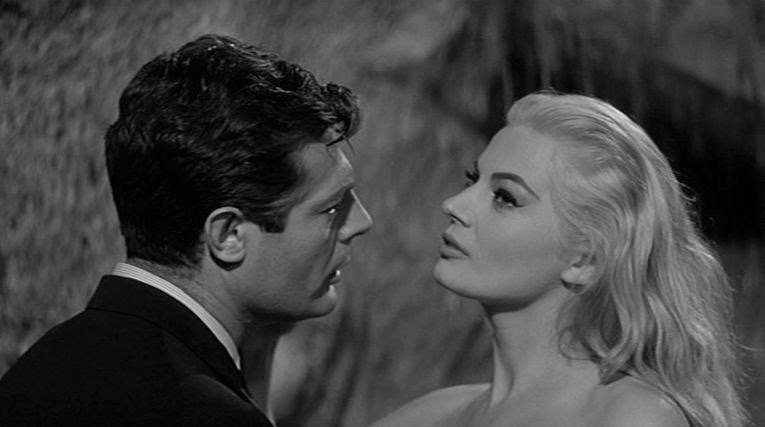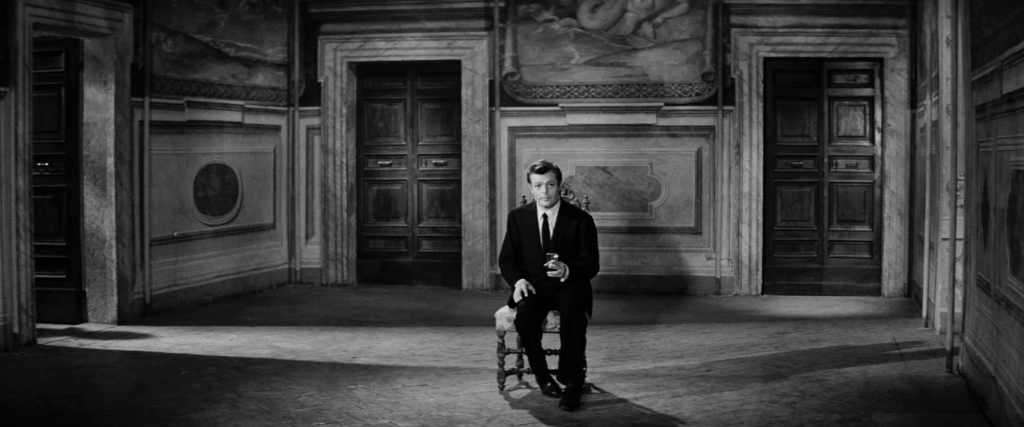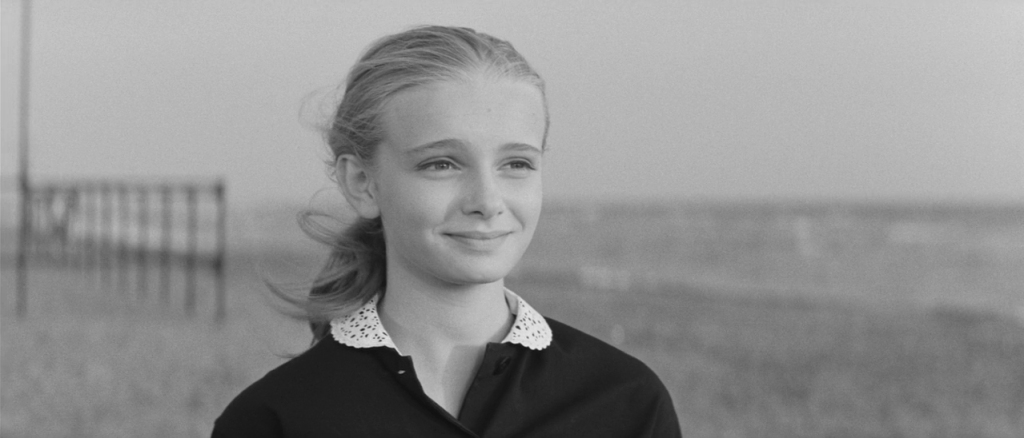“Even the most miserable life is better than a sheltered existence in an organized society where everything is calculated and perfected.”
Marcello, a tabloid journalist, and Sylvia, an American actress, wade into the Trevi Fountain in La Dolce Vita‘s most iconic scene — him in a black suit and tie, her in a long, elegant, strapless, black dress. Director Federico Fellini frames her in a close-up as she tilts her head back, closes her eyes, and listens to the water falling into the pool below her. She reaches her hand out to feel the rushing water against her skin. Marcello enters the frame and reaches for her face, but does not touch her. Fellini frames them in an intimate, profile two-shot. They seem to lose all sense of their surroundings as they focus intensely on each other, as do we. Enchanted by her, Marcello rhetorically asks, “Sylvia, who are you?” She wordlessly replies by opening her eyes, reaching her hand above his head, and dripping water on his hair.
It’s a romantic, sensual moment. We wait for them to kiss.
They don’t.
Instead, Marcello glances frantically over his shoulder, sensing that something is wrong. Fellini breaks the intimacy of the scene by cutting to a wide shot of the Trevi Fountain. Marcello and Sylvia remain locked in an embrace in the center of the pool, but are dwarfed by the magnificent statues around them. The night has inexplicably given way to morning. The water stopped flowing. A delivery boy sits on his bicycle on the right-hand side of the frame, staring at them while holding a box over his head, no doubt wondering what on earth is going on as they wade out of the pool hand-in-hand.
The moment has shattered, the magic of the night has passed, and they must, in the following scene, face the consequences of their actions in front of a horde of paparazzi cameras and Sylvia’s hungover, angry boyfriend. The ending of this famous fountain scene is not its most-mentioned beat, but it is its most important.
La Dolce Vita, after all, is not simply about the allure of “the sweet life,” but the emptiness and aimlessness that remains when fleeting dalliances have passed.

There are three women whom Marcello actively pursues in La Dolce Vita: Sylvia, the exciting novelty; Emma, his unstable fiancée; and Maddalena, a kindred spirit. Each of these women serves as a foil for Marcello; his interactions with them reveal to us what he desires, and what he runs away from.
Sylvia is involved with him for only a day, while the others linger in his life over time. Each pursuit, however, ends in pain, because of the transient nature of his commitments.
The narrative structure of La Dolce Vita is episodic, much like Marcello’s life. Most episodes are about Marcello’s interactions with one of his foils. Fellini leaves most of the storylines within those episodes emotionally unresolved, just as the interactions that they document are for his protagonist.
Marcello has an enchanting night out in Rome with Sylvia, then never sees her again after her boyfriend unceremoniously beats him outside of her hotel.
He turns to Maddalena for comfort time and time again, but realizes too late that she, like him, is in constant pursuit of the next shiny object — a person who cannot be tethered down. Their dalliance ends with Marcello sitting alone in an ostentatious room filled with stunning art and extravagant interior decor. Maddalena speaks to him through a fountain, and each professes their love to the other from separate rooms.
But it’s a lie. The scene ends with Fellini cutting between an intimate close-up of another man seductively kissing Maddalena on the neck and a lonely wide shot of Marcello, alone, in this gaudy room. “I’ve never wanted to choose,” Maddalena confesses to him near the end of this scene, before her secret, silent seduction.
They never see each other again.

Fellini doesn’t allow Marcello to pause or process this loss. Marcello, and the film, simply rushes on to the next episode.
Unable to self-soothe, Marcello reacts by seducing another woman that same night. Fellini lingers on a tender shot of their hands clasped together as they stroll toward a bedroom, then ends the sequence with a point-of-view shot in which the camera dollies directly into her face, enveloping the frame in surreal darkness. Fellini then cuts to a shot of the gardens outside of the palace the following morning. A gnarled, broken statue of an armless, legless, naked man with the head of a bull sits on a stump at the garden’s edge. It’s too bizarre — and too perfect — an image to not be an intentional metaphor for Marcello’s animalistic urges.
Emma, Marcello’s fiancée, is the only woman who truly loves him — but their relationship is toxic. He cheats on her and abandons her; she overdoses on drugs while waiting for him to come back, then demeans him when he does.
After the first overdose in the film, Marcello frantically rushes her to the hospital, and Fellini takes care to show us the panic in his eyes as he does so. But in the hospital, Fellini frames him small and alone in a wide shot of the waiting area while he calls another woman — Maddalena — for comfort.
The final argument between Marcello and Emma, which takes place in a car at night on an isolated highway, and its resolution the following morning, is the perfect embodiment of their relationship: intense emotion, followed by a reluctant reunion.

Fellini structures most sequences in La Dolce Vita with a similar emotional duality, albeit generally one with a more positive start: excitement and fun, followed by pitiful resolution.
One of the most poignant sequences in the film begins just after the midpoint. In it, Marcello dines, drinks, and dances the night away with his estranged father, who ultimately leaves the nightclub with a beautiful woman. Later that night, Marcello hears a frantic report that his father is ill. He panics and races to his father’s side at the woman’s apartment. The formerly boisterous father sits stoically, staring out at Rome through an open balcony door. Marcello wants the father to spend the day in the city with him. The father wants to return to his own home and his wife.
The sequence ends with an overhead shot of Marcello standing alone in the street, watching his father’s taxi drive away.
The sequence is poignant for several reasons, not least of which because of the context delivered in an exchange between Marcello and the photographer Paparazzo at dinner (“When I was a boy… he’d be away weeks at a time. He was never there. How my mother cried! I almost never saw him. I hardly even know him.”) But it is most depressing because we — and Marcello — see in his father what Marcello will become if he does not change his ways, and we — and he — know that he will not.
All of these character foils — the lovers and the father — deepen our understanding of Marcello, and are the focal point of the film’s episodic adventures.
Sylvia shows us what he idolizes, Emma shows us what he despises, Maddalena shows us what he relates to, and his father shows us what he’ll become.
Then, when enough episodes have passed to fully reveal Marcello’s nature to us, Fellini flashes forward into his near future.
La Dolce Vita ends with a party in the beachside home of a wealthy divorcee. Marcello, now a little older, appears more desperate and unhinged, and his cynical, raucous comments generate little of the joy that they generated before — he is openly greeted with displeasure and dismay from the other party guests. Near the end of this scene, Fellini frames him in the center of a wide shot, shrouded in shadows, as he rips feathers out of a pillow, both for his own amusement and the degradation of a woman at the party.
In this climactic scene, the melancholic tone that simply concluded many of the film’s sequences takes center stage. It turns La Dolce Vita into a cautionary tale about what a man becomes when he continues to live a hedonistic lifestyle past his prime.

La Dolce Vita is a film about the dissatisfaction and disappointment caused by chasing after a presumed reality that does not exist.
Fellini explores this through three lenses: love and lust, wealth and luxury, and celebrity and fame.
Love and lust are the focus of Marcello’s dalliances, detailed above. Wealth and luxury, like love and lust, are ephemeral aims for Marcello, whose own apartment is small, minimally furnished, and lined with empty white walls, but whose friends live in extravagant places.
Behind the closed doors of the luxury estates Marcello finds himself in, however, nothing is as glamorous as it seems. Fellini takes great care to present the wealthy characters Marcello idolizes as either depressed, aimless, or insufferable.
During a party late in the film, a tracking shot follows Maddalena down a hallway as she points out who’s who to Marcello while the wealthy elites around them flirt and fight and sit alone on windowsills situated between beautiful paintings. “Little Eleonora: 200,000 acres and two suicide attempts,” she says, describing one of them.
“At least they do these things with a certain elegance,” she later adds.
The character of Marcello’s rich friend, Steiner, is the perfect embodiment of this; he is a man who has it all, in Marcello’s eyes — but then he throws it all away in a fit of existential despair.
Marcello desperately craves to be a member of high society, but when he is invited as a guest into it, he gets no satisfaction from it… just as he finds no lasting satisfaction from any of his lovers.
In a particularly amusing scene set at Steiner’s gorgeous apartment, Marcello refuses to mingle with Steiner’s elite guests. When the rich women request that they all listen to the recorded sounds of birds and ocean waves instead of conversing, Fellini cuts to a shot of Marcello sighing in disbelief and resting his head solemnly against an ornate statue. Later, he sits alone on the floor and pets the family dog.
La Dolce Vita also explores the reality of celebrity and fame, primarily through the actions performed by another group of characters: tabloid photographers. The paparazzi chase after actors, actresses, and other people of renown throughout the film, often at the most inopportune — and inappropriate — moments. They snap photo after invasive photo of beautiful people whose lives are envied by the masses.
Fellini’s film invented the term “paparazzi”; the word refers to the name of the primary photojournalist character, Paparazzo. Through this character’s relentless actions, and those of his crew, Fellini leaves us with no uncertainty that people like Sylvia and Maddalena and Steiner are characters whose lives are broadly viewed as better than the average person’s life, and therefore worthy of documentation and adoration.
Fellini then spends the rest of the film peering behind that façade. La Dolce Vita focuses on the dismal reality of their lives, which are often far from an existence that anyone should want to emulate.

Fellini bookends La Dolce Vita with two surreal scenes that serve as moral metaphors. These scenes contrast starkly with the hedonistic episodes that play out in between.
The film begins with shots of a statue of Jesus being flown over Rome in a helicopter; arms outstretched, it appears as though he is blessing the Eternal City.
But then, Fellini cuts to a low angle shot of sunbathing women in bikinis on a rooftop. “Look, it’s Jesus!” one of them screams excitedly, waving at the statue as it passes. The slight sacrilege of this introductory moment is reflected in the kinetic way in which the camera tracks Sylvia as she frenetically runs up the stairs of St. Peter’s Basilica dome later on, and in how she absentmindedly autographs her name on a sacred stone window frame during her ascent.
Sanctity and virtue — especially religious virtue, a quality so superficially important to Rome — are tossed out of the proverbial window by Marcello and everyone he surrounds himself with.
The film ends with a scene on a beach. There, Marcello sees a young, innocent girl whom he recognizes on the other side of a small inlet of saltwater. She motions to him from afar, calling him to join her. He kneels on the other side of the beach, refusing the call. Perhaps he recognizes that she is innocent, and that he would taint her if she were to spend any considerable amount of time with him. She smiles in his direction. He shrugs his hands in the air and turns away.
Better to get drunk with his own, broken companions than risk destroying someone whose life has more optimistic promise.

